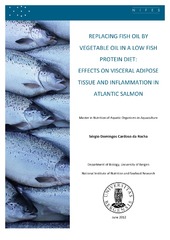| dc.description.abstract | Dietary fish oil (FO) replacement with vegetable oils in combination with high dietary fish meal replacement have previously been shown to increase Atlantic salmon plasma and liver TAG as well as visceral fat deposition. In human subjects increased visceral adiposity may lead to chronic low grade inflammation and may have health implications. Furthermore, decreasing the n-3/n-6 ratio by increasing dietary n-6 fatty acids may influence inflammation status. We investigated the combined effect of fish oil and fish meal replacement on visceral adipose tissue lipids and inflammation in Atlantic salmon. Fish with an initial weight of ≈ 800 g were fed an experimental diet for 28 weeks where 70% of the fish meal was replaced by a plant protein blend. The control diet contained 100% fish oil, whereas the 80% of the fish oil was replaced by either rapeseed oil (RO), olive oil (OO) or soybean oil (SO) in the three experimental diets. This resulted in high (FO), intermediate (RO and OO) and low (SO) dietary n-3/n-6 ratio, whereas the marine omega-3 level was stable at 5% in all VO diets. To this work we analyzed the fatty acid composition of visceral fat, the macrophage infiltration in visceral adipose tissue through histological observation and gene expression of inflammatory markers and macrophage precursors in visceral adipose tissue and head kidney. There was no statistical significant different in final weight, length, visceral somatic index and in adipocyte size of visceral adipose tissue. Visceral adipose tissue highly reflected the dietary fatty acid composition. There was no difference in total fatty acids, but there was difference in fatty acid composition between the dietary groups. There was higher eicosapentaenoic acid (20:5 n- 3, EPA), docosahexaenoic acid (22:6 n-3, DHA) and arachidonic acid (20:4 n-6, AA) in FO fed fish. On the other hand, 18:2n-6, 18:1n-9 and 18:3n-3 were present in higher levels in fish fed diets with vegetable oils. As a result, the n-3/n-6 ratio was higher in FO dietary group and fish feed with SO diet had the lowest ratio. There was macrophage infiltration in all dietary groups but at a very low level, mainly in fish feed with OO and FO. The SO dietary group had the highest macrophage infiltration. Nevertheless the macrophage accumulation was not at a level to be considered as inflammation, being in line with the mRNA levels of cytokines and macrophages genes. With this we can conclude that the replacement of fish oil by olive oil, rapeseed oil or soybean oil in 80% does not have an influence on adiposity or low-grade inflammation in visceral adipose tissue. | en_US |
